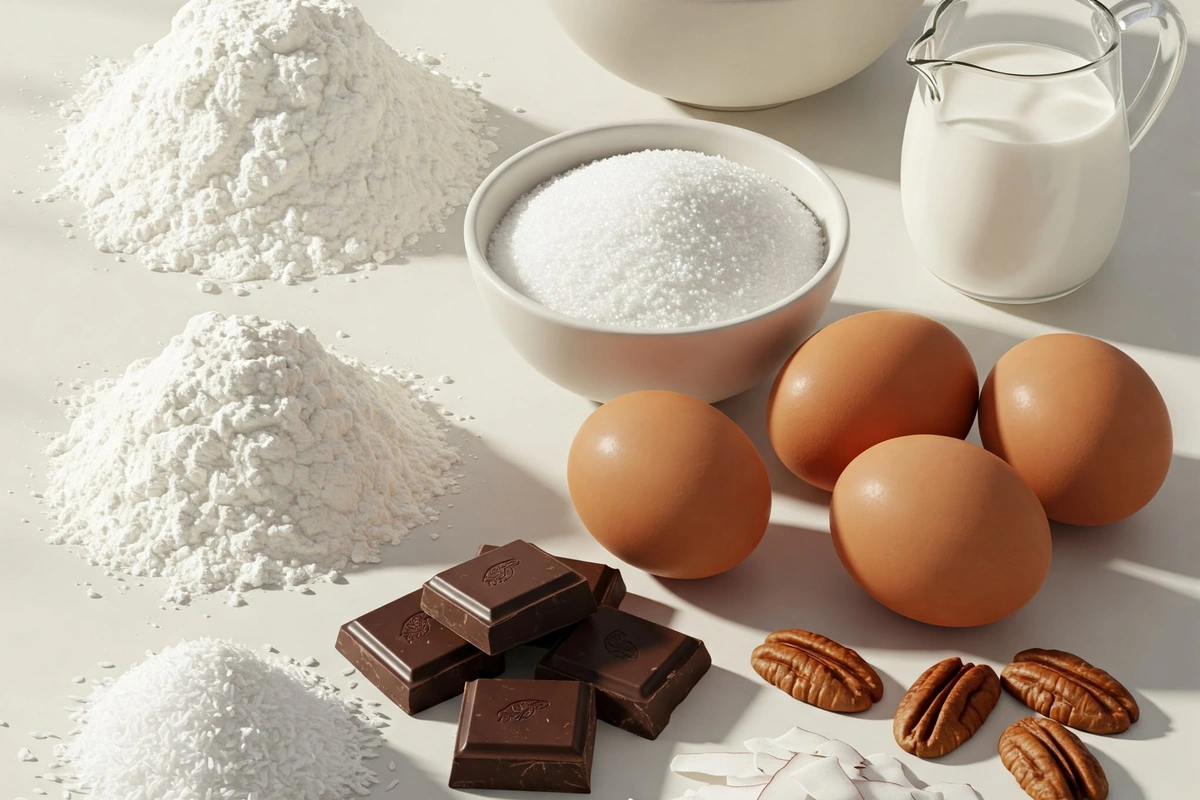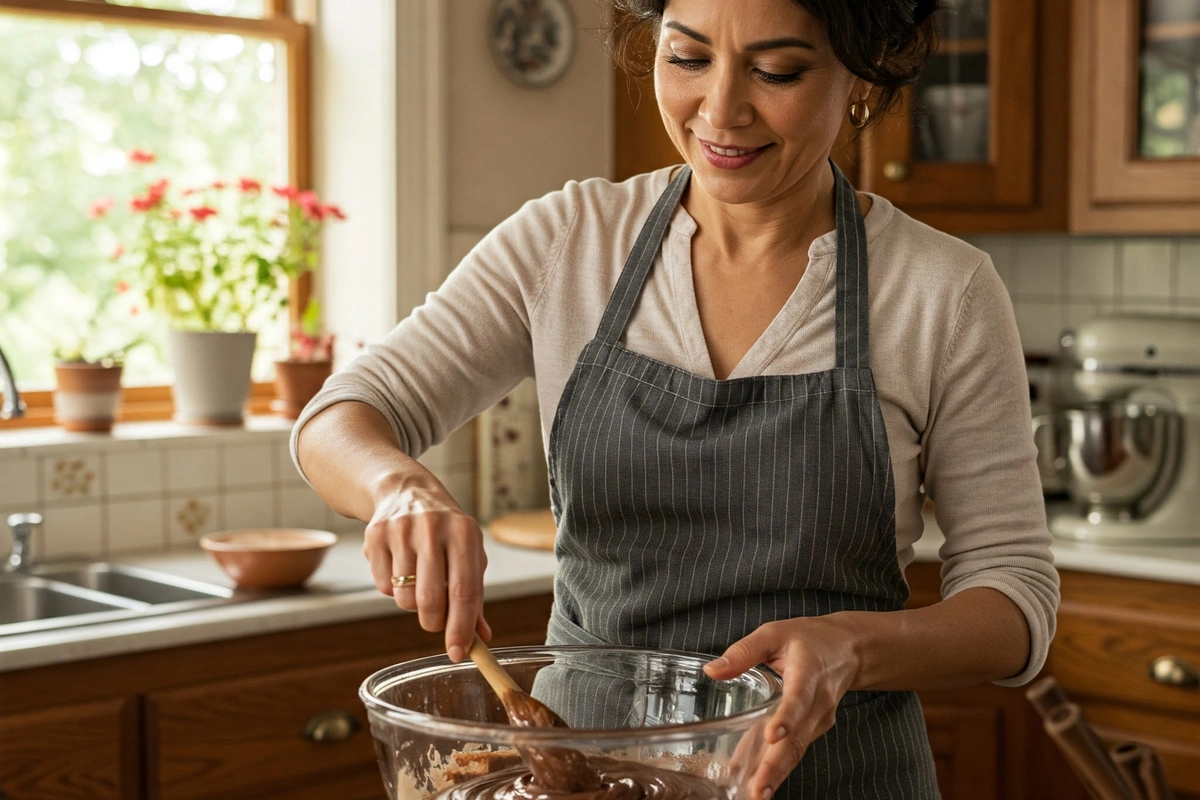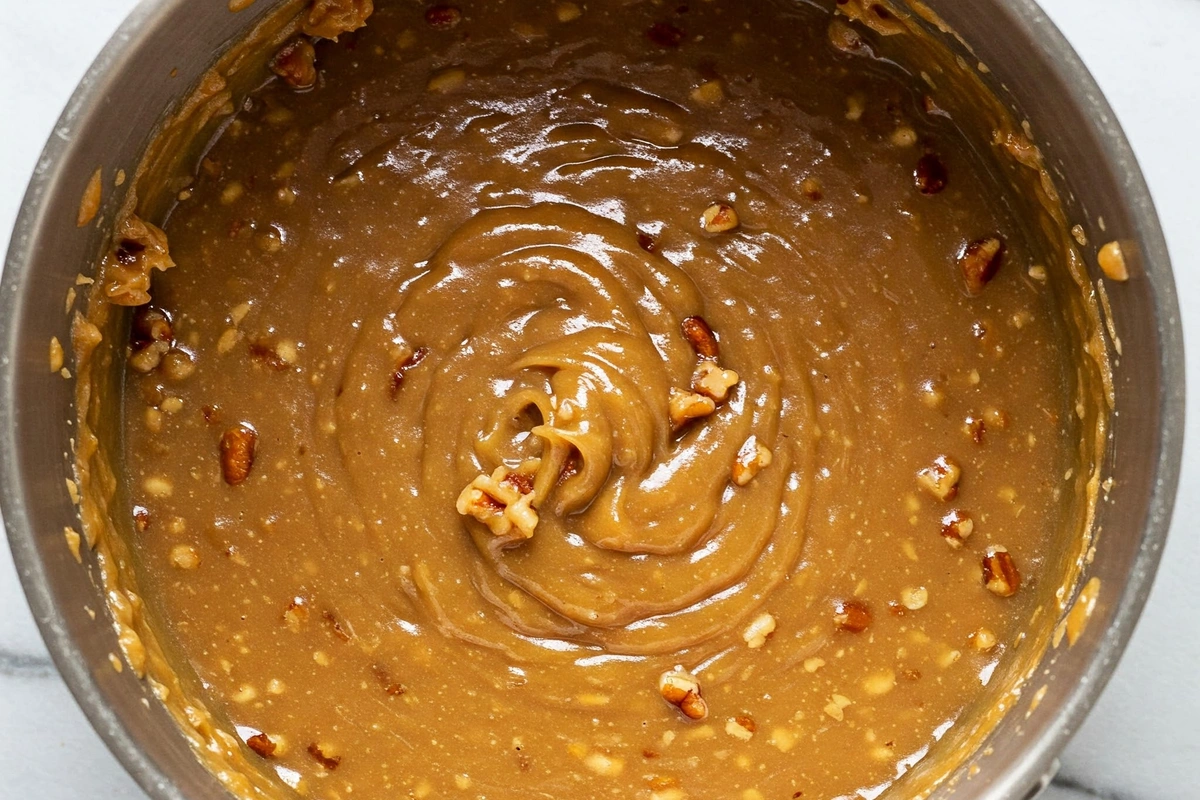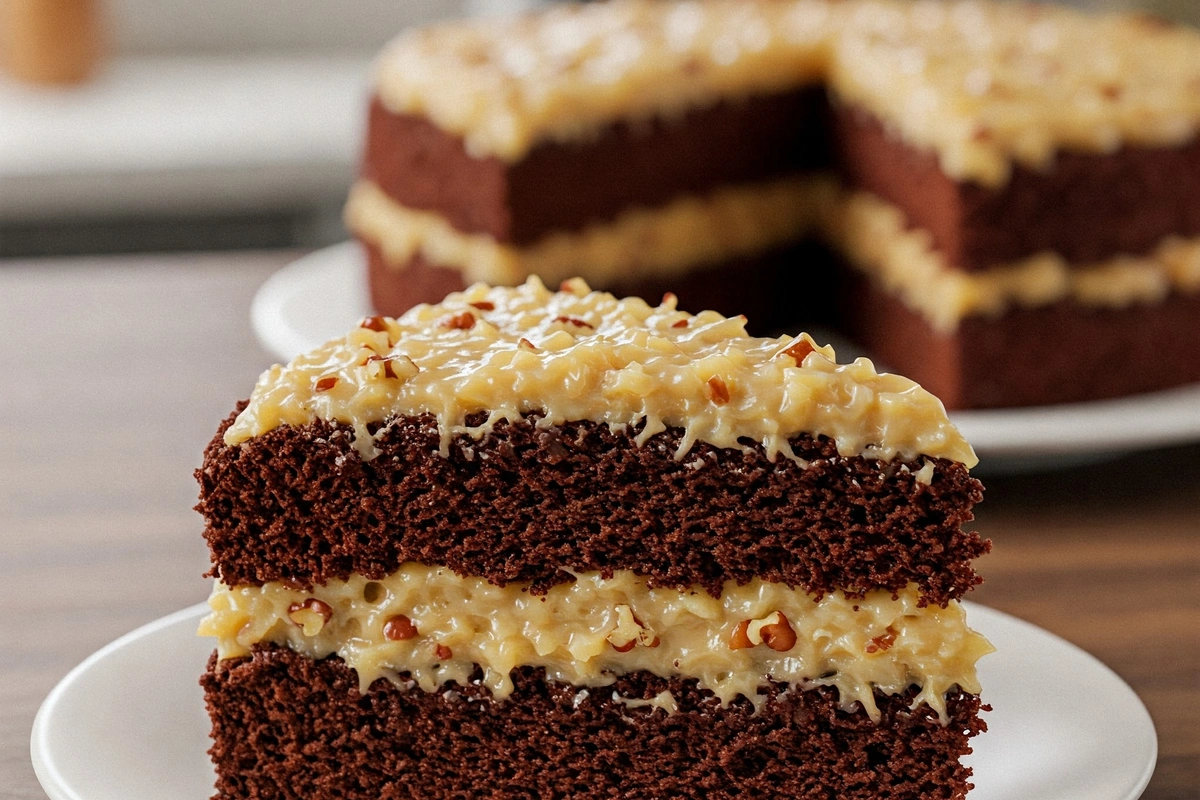Savor the rich delight of our best German chocolate cake recipe. Learn its origins, secrets, and tips for a moist and decadent dessert.
Why Choose German Chocolate Cake
German chocolate cake stands out with its unique coconut-pecan frosting. People often crave its moist texture and sweet filling. Basically, this chocolate dessert is considered an American classic, although its name might suggest otherwise. Altogether, it is prized for its luscious layers and characteristic icing that combines a smooth, creamy consistency with subtle crunch.
Comparatively, other chocolate cakes may use a traditional buttercream. However, German chocolate cake steps away from the norm. It offers a rich coconut and pecan topping that perfectly complements the tender chocolate layers beneath. Equally, the balance between sweet and savory notes makes this dessert unforgettable.
Additionally, the special baking chocolate used in the batter ensures a mild, sweet cocoa flavor. Consequently, the cake remains perfectly moist when prepared with buttermilk or a similar ingredient. Indeed, the final result is a deep, enticing dessert that appeals to anyone who adores chocolate.
The Origins of German Chocolate Cake
Initially, people might believe this treat comes from Germany. However, it actually has American roots. In 1852, an English-American chocolatier named Samuel German developed a sweet baking chocolate for the Baker’s Chocolate Company. This product was labeled “German’s Sweet Chocolate,” which eventually inspired the creation of the original “German’s Chocolate Cake.” Over time, the possessive apostrophe fell away, leading to today’s well-loved German chocolate cake.
Eventually, the cake recipe found its way into the mainstream thanks to newspaper recipe promotions. Consequently, it rose in popularity during the mid-20th century. Advertisements showcased its unique use of sweet baking chocolate instead of the regular variety. Furthermore, consumers became enamored with the distinct coconut-pecan frosting. Undoubtedly, the name stuck, even if most folks no longer recall the story of Sam German.
Chiefly, the name might cause confusion, yet the cake’s flavor transcends any historical mix-up. Many home bakers consider it an iconic part of American dessert culture. Likewise, bakeries often feature it as a specialty item, especially around holidays and special occasions. Ultimately, the tradition of this delightful cake continues, bridging the past with the present.
For more tips on perfect cooking techniques, check out the Peach Crisp Recipe on Simita Recipes.
Expert Tips for Perfect German Chocolate Cake
Everyone wants a flawless outcome when baking. Thus, mastering a few key points helps guarantee success. Follow these insights for perfect results:
- Use room-temperature ingredients: Ensure your eggs, butter, and buttermilk are not cold. This step helps them blend more smoothly.
- Measure accurately: Weighing flour and sugar produces the most consistent results. Generally, this prevents overly dense or dry cakes.
- Don’t overmix: Once the dry ingredients merge with the wet mixture, stir carefully. Too much mixing can yield a tough crumb.
- Check for doneness: Bake until a toothpick inserted in the center emerges with only a few moist crumbs. If it comes out entirely clean, you might have overbaked it.
- Cool completely: Let the layers rest before frosting. Consequently, this stops the icing from melting or sliding off.
By following these guidelines, you will avoid the most common pitfalls. Furthermore, you can impress guests with a tender, melt-in-your-mouth cake every time. Basically, success lies in patience, proper technique, and high-quality ingredients.
Secrets Behind Moist German Chocolate Cake Layers
Moist chocolate layers form the heart of any wonderful dessert. German chocolate cake proves no exception. Particularly, the recipe often includes buttermilk or sour cream, which helps keep each bite tender. However, careful folding of the batter is another crucial step. Additionally, incorporating the right amount of fat ensures the crumb remains soft.
Because the batter requires sweet baking chocolate, that extra cocoa butter content boosts richness. Chiefly, selecting quality chocolate is vital. Consequently, the texture becomes more luxurious. Moreover, always watch your baking time closely. Overbaking can sabotage moisture, turning a once-luscious crumb into something crumbly.
Choosing the Right Ingredients for German Chocolate Cake
Equally, ingredient quality matters for flavor and texture. German chocolate cake centers on sweet chocolate, so it’s best to choose a reputable brand. Furthermore, freshly shredded sweetened coconut improves the classic frosting. Pecans should also be fresh, not stale. Meanwhile, the brown sugar and evaporated milk used in the frosting must be high quality.
Another tip involves using pure vanilla extract rather than imitation. Undoubtedly, the aroma and depth of real vanilla elevate the cake’s overall taste. In contrast, cheap or artificial flavorings can dull its signature richness. Finally, do not underestimate the importance of salted butter. That subtle salt note in the frosting helps contrast the sweetness, balancing the overall profile.
Making Your German Chocolate Cake Stand Out
Many bakers like to add personal twists. Specifically, some people enhance the frosting with chopped toasted pecans or drizzle melted chocolate on top. Meanwhile, others garnish the finished dessert with fresh berries or edible flowers. Basically, the options are endless. Nonetheless, keep the coconut-pecan center stage, as it is the hallmark of this particular cake.
Consider slicing each layer into thinner rounds if you want multiple frosting layers. Consequently, you get additional coconut-pecan filling in every bite. Another approach is to add a thin layer of chocolate ganache between the layers for extra decadence. Furthermore, you can pipe whipped cream around the edges for an elegant presentation. Ultimately, the goal is to highlight the distinctive components of this cherished dessert in a unique way.
Essential Ingredients and Step-by-Step Preparation
Below is a straightforward list of components for both cake and frosting. Feel free to make small adjustments based on your tastes or dietary needs:
- Cake Ingredients
- 2 cups all-purpose flour
- 1½ cups granulated sugar
- 1 cup buttermilk (or sour cream substitute)
- 1 cup unsalted butter, softened
- 4 large eggs, room temperature
- 4 ounces sweet baking chocolate, melted and cooled
- ½ cup unsweetened cocoa powder (optional if you prefer extra chocolate intensity)
- 1 teaspoon baking soda
- 1 teaspoon baking powder
- ½ teaspoon salt
- 1 teaspoon pure vanilla extract
- Frosting Ingredients (Coconut-Pecan Topping)
- 1 cup evaporated milk
- 1 cup brown sugar
- 3 large egg yolks
- ½ cup salted butter
- 1½ cups shredded sweetened coconut
- 1 cup chopped pecans
- 1 teaspoon pure vanilla extract
Cake Preparation
- Preheat your oven to 350°F (175°C). Meanwhile, grease and flour two 9-inch round cake pans.
- Cream the softened butter and sugar until fluffy. This usually takes around three minutes with a stand mixer.
- Add the melted sweet baking chocolate. Mix thoroughly. Then, incorporate the eggs one at a time, blending after each addition.
- Combine dry ingredients (flour, cocoa powder, baking soda, baking powder, salt) in a separate bowl.
- Alternate adding the dry mixture and buttermilk to the butter-sugar-egg mixture. Do this in three parts, mixing on low speed.
- Stir in the vanilla extract. Be mindful not to overmix.
- Divide the batter between the prepared pans. Tap gently on the counter to remove air bubbles.
- Bake for about 25-30 minutes, or until a toothpick inserted in the center comes out with a few moist crumbs.
- Cool in the pans for 10 minutes, then invert onto wire racks. Let the layers cool completely before frosting.
Coconut-Pecan Frosting Preparation
- Whisk the evaporated milk, brown sugar, and egg yolks in a medium saucepan over low to medium heat.
- Add the salted butter, and stir until it melts. Keep whisking to prevent scorching.
- Simmer the mixture until it thickens. This typically takes about 10-12 minutes. It should coat the back of a spoon.
- Remove from heat, then stir in the shredded coconut, pecans, and vanilla extract.
- Allow the frosting to cool to a spreadable consistency. Consequently, it will thicken more as it cools.
Assembly and Decoration
Once the cake layers and frosting have cooled, it is time to assemble everything. Initially, place one layer on a cake stand or serving plate. Then, spread a generous amount of coconut-pecan frosting on top. Another tip is to spoon the frosting all the way to the edges so it peeks out of the sides.
Place the second layer on top. Subsequently, add the remaining frosting, letting some naturally drip over the edge for a rustic look. Because this frosting is thick, you generally do not need an additional “crumb coat.” However, you can smooth the sides if you prefer a more polished finish.
Consider adding garnish. Some bakers top the finished cake with extra toasted pecans or coconut flakes. Others add a drizzle of melted chocolate. Ultimately, you decide how best to showcase this dessert’s classic charm.
Baking Variations and Serving Ideas
Many love the classic format of two round layers. Nonetheless, you could create cupcakes for individual servings. Fill lined muffin tins two-thirds full and bake for around 18-20 minutes. Afterward, top each with a dollop of coconut-pecan frosting. Kids especially enjoy these mini treats.
Alternatively, a sheet cake version is perfect for potlucks or large gatherings. Use a 9×13-inch pan and increase the baking time by a few minutes. Ensure you test for doneness with a toothpick or skewer. Consequently, you can frost the entire surface once it cools. This method provides an easier approach to slicing and serving.
Moreover, adding a thin layer of ganache between cake layers adds a modern flair. Conversely, you can add whipped cream or a cream cheese-based frosting if you want a lighter taste. The main point is to let the signature coconut-pecan filling shine. Indeed, that is the unmistakable hallmark of German chocolate cake.
Storing and Freezing
Keeping your cake fresh is crucial. Basically, store leftover slices in an airtight container at room temperature for up to three days. If you live in a humid environment, refrigerate it. However, bring it back to room temperature before serving to maintain the best flavor and texture.
For long-term storage, freeze individual slices or the entire cake. Wrap the cake tightly in plastic wrap, then place in a freezer-safe bag or container. When you want to enjoy a slice, transfer it to the refrigerator to thaw. Let it come to room temperature before savoring every bite.
Nutritional Information (Per 100g)
Below is an approximate snapshot of what you might find in each 100-gram serving of this luscious dessert. Values may vary based on ingredient brands and substitutions.
| Nutrient | Amount |
|---|---|
| Calories | 410 kcal |
| Fat | 20 g |
| Carbohydrates | 52 g |
| Protein | 5 g |
| Sugars | 35 g |
| Dietary Fiber | 3 g |
| Sodium | 180 mg |
Creating Joy with Every Slice
While some desserts come and go, German chocolate cake remains an enduring favorite. Because the recipe is easy to adjust, you can create a version that suits your taste. Indeed, many families make it an annual tradition for birthdays or holidays.
Notably, the alluring contrast between the chocolate layers and the coconut-pecan topping sets this cake apart. Ultimately, you can add flair with garnishes or keep it simple and classic. Either way, each bite delivers a harmonious blend of sweetness and texture. Basically, there is no substitute for this timeless specialty.
Moreover, sharing a homemade cake with loved ones fosters a sense of warmth and camaraderie. This dessert in particular has a knack for turning ordinary moments into cherished memories. There is no reason to wait for a celebration. Baking one on a casual weekend can be just as delightful.
Fun Twists and Flavor Enhancements
1. Chocolate Chips
Sprinkle semi-sweet chocolate chips onto each frosted layer before stacking them. This approach boosts chocolate flavor and adds a slightly different texture.
2. Caramel Drizzle
Drizzle caramel sauce over the top layer. Subsequently, it blends with the coconut-pecan topping, creating a richer taste.
3. Extra Crunch
Toast the pecans before folding them into the frosting. Toasting heightens their nutty flavor.
4. Fruit Infusion
Add sliced bananas between the layers for an unexpected twist. Alternatively, fresh raspberries can also balance the sweetness.
Basically, do not be afraid to experiment. Another advantage of this cake is its versatility. Nonetheless, keep an eye on the ingredients to maintain that classic German chocolate cake character.
Confidence in Your Baking Journey
Baking can feel intimidating, especially when working with multiple steps. However, step-by-step organization helps. Gather everything ahead of time. Hence, you will stay on track. Another tip is reading through the recipe thoroughly before starting. Thus, you will understand the sequence of steps.
Especially if you are new to baking, embrace the learning process. Mistakes might happen, yet each error is an opportunity to improve. Equally, always taste your batter and frosting along the way (unless raw eggs pose a safety concern). Monitoring flavor ensures you can adjust sugar or chocolate intensity accordingly.
Because German chocolate cake has a reputation for being slightly more involved, succeeding at it can be quite rewarding. Indeed, presenting the final result to family or friends provides a sense of accomplishment that justifies the effort. Meanwhile, the accolades you receive will only reinforce your love for homemade sweets.
Preserving a Classic Tradition
While food trends come and go, German chocolate cake persists. It reminds us of mid-century Americana, back when recipes traveled by word of mouth and local newspapers. Consequently, it stands as a testament to how a single invention—Sam German’s sweet chocolate—can spark widespread culinary inspiration.
Over time, this dessert has evolved. People experiment with fillings, frosting techniques, and even layering styles. Nevertheless, the essence remains the same: moist chocolate layers crowned with an unforgettable coconut-pecan topping. In a world of fancy patisserie and gourmet confections, this cake stays close to its roots, offering a taste of tradition with every slice.
Undoubtedly, that connection to the past resonates with many bakers today. Indeed, it is a reminder that good recipes endure because they touch hearts, not just taste buds. Furthermore, handing down a cherished cake recipe from generation to generation keeps stories alive. In effect, each time you bake it, you become part of that timeless tradition.
Serving Suggestions and Pairings
Pairing matters. A slice of German chocolate cake pairs wonderfully with:
- Fresh Berries: Strawberries, raspberries, or blackberries cut the sweetness with a hint of tart flavor.
- Whipped Cream: A light dollop of unsweetened cream can soften any overly sweet note.
- Ice Cream: Vanilla or coffee ice cream complements chocolate undertones beautifully.
- Coffee or Espresso: The subtle bitterness of coffee underscores the cake’s richness.
Subsequently, consider adding a dusting of cocoa powder to your plate for a decorative flourish. Alternatively, a drizzle of raspberry sauce can heighten the visual appeal. Essentially, presentation can be as enjoyable as the baking process itself. Because this dessert is often served on special occasions, going the extra mile with garnishes feels natural.
FAQ : German chocolate cake
Q1: Is German chocolate cake actually German?
No. Despite the name, it is not from Germany. The cake is named after Samuel German, an English-American who created the sweet baking chocolate used in the recipe.
Q2: How do I store leftover cake slices?
Wrap each slice tightly in plastic wrap or place them in an airtight container. You can keep them at room temperature for up to three days. In a humid area, store them in the fridge and let them come to room temperature before serving.
Q3: Why is my coconut-pecan frosting so runny?
This usually happens if it was not cooked long enough. The mixture should simmer and thicken for about 10-12 minutes. Always let it cool and set before spreading it on the cake.
Q4: Can I make a vegan version of German chocolate cake?
Yes. You can use plant-based milk and vegan butter. Also, replace the eggs with a flaxseed or applesauce alternative. Be sure to choose dairy-free chocolate as well. Adjust the texture and taste accordingly.
Q5: Is it possible to reduce the cake’s sweetness?
Certainly. Cut down a bit on sugar in both the batter and the frosting. You can also opt for a darker chocolate variety. Nonetheless, be aware that sweetness is a defining feature of German chocolate cake.
Altogether, these questions capture common concerns about this beloved dessert. With the tips and tricks shared here, you will be prepared to bake, serve, and enjoy a delicious German chocolate cake for any occasion.
Print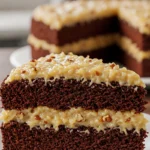
The Best German Chocolate Cake Recipe
- Total Time: 1H
- Yield: 10 servings 1x
- Diet: Vegetarian
Description
A moist and decadent German Chocolate Cake featuring layers of sweet chocolate sponge, crowned with a rich coconut-pecan frosting. Its creamy topping and delicate crumb make it an irresistible dessert for special occasions or any time you crave a luscious chocolate treat.
Ingredients
-
The Cake:
- 2 cups all-purpose flour
- 1 ½ cups granulated sugar
- ½ cup unsalted butter, softened
- 1 cup buttermilk (room temperature)
- 4 large eggs (room temperature)
- 4 oz sweet baking chocolate, melted and cooled
- 1 teaspoon baking soda
- 1 teaspoon baking powder
- ½ teaspoon salt
- 1 teaspoon pure vanilla extract
-
For the Coconut-Pecan Frosting:
- 1 cup evaporated milk
- 1 cup packed light brown sugar
- 3 egg yolks
- ½ cup salted butter
- 1 ½ cups sweetened shredded coconut
- 1 cup chopped pecans
- 1 teaspoon pure vanilla extract
Instructions
- Preheat your oven to 350°F (175°C). Grease and flour two 9-inch round cake pans.
- Cream the softened butter and granulated sugar in a mixing bowl until light and fluffy (about 2–3 minutes).
- Add the melted sweet baking chocolate and mix well.
- Incorporate the eggs one at a time, beating after each addition.
- Combine the flour, baking soda, baking powder, and salt in a separate bowl.
- Alternate adding the dry ingredients and the buttermilk into the butter-sugar-egg mixture, mixing on low speed. Finish by blending in the vanilla extract.
- Divide the batter evenly between the prepared pans. Bake for 25–30 minutes, or until a toothpick inserted in the center comes out with only a few moist crumbs.
- Cool the cakes in their pans for about 10 minutes before transferring to wire racks to cool completely.
Coconut-Pecan Frosting
- Combine the evaporated milk, brown sugar, and egg yolks in a medium saucepan over medium heat, stirring continuously.
- Add the salted butter and stir until it melts. Continue cooking until the mixture thickens (8–10 minutes).
- Remove from heat and stir in the shredded coconut, chopped pecans, and vanilla extract. Let the frosting cool to a spreadable consistency.
Assembly
- Place one cooled cake layer on a serving plate. Top it generously with the coconut-pecan frosting, spreading evenly to the edges.
- Add the second cake layer on top. Spread the remaining frosting over the top of the cake.
- Garnish with additional toasted pecans or shredded coconut if desired.
Notes
- Variations:
- Substitute buttermilk with plain yogurt or sour cream if preferred.
- For extra chocolate intensity, add 2 tablespoons of cocoa powder to the batter.
- Tips:
- Make sure to let the cake layers cool completely before frosting to prevent the icing from melting.
- Toast the pecans before adding them to the frosting for a deeper, nutty flavor.
- Allergies/Intolerances:
- This recipe contains dairy (milk, butter) and nuts (pecans). Use appropriate substitutes (e.g., coconut milk, dairy-free butter, different nuts or seeds) if needed.
- Taste Adjustments:
- To reduce sweetness, slightly decrease the sugar in the batter and frosting.
- For a richer chocolate flavor, increase the amount of sweet baking chocolate or add semi-sweet chocolate chips to the batter.
- Prep Time: 30Min
- Cook Time: 30Min
- Category: Dessert, Cake
- Method: Oven
- Cuisine: American
Nutrition
- Serving Size: 1/10 of recipe
- Calories: ~490 kcal
- Sugar: ~40 g
- Sodium: ~300 mg
- Fat: ~25 g
- Saturated Fat: ~15 g
- Unsaturated Fat: ~8 g
- Trans Fat: 0g
- Carbohydrates: ~60 g
- Fiber: ~3 g
- Protein: ~6 g
- Cholesterol: ~85 mg
Keywords: german chocolate cake, chocolate dessert, coconut-pecan frosting, homemade cake, sweet baking chocolate, classic cake recipe


